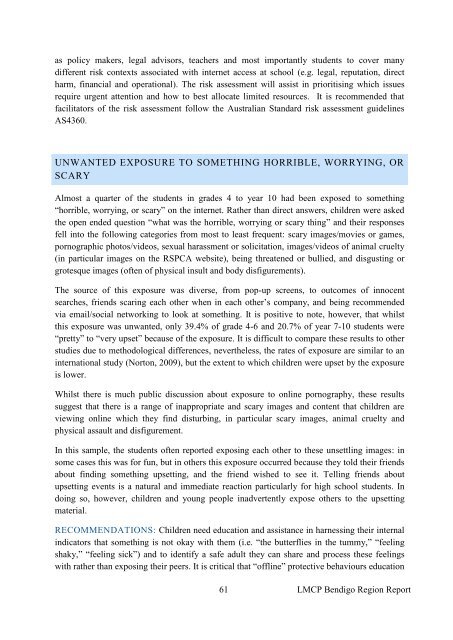LODDON MALLEE - Cyber Safe Kids
LODDON MALLEE - Cyber Safe Kids
LODDON MALLEE - Cyber Safe Kids
Create successful ePaper yourself
Turn your PDF publications into a flip-book with our unique Google optimized e-Paper software.
as policy makers, legal advisors, teachers and most importantly students to cover many<br />
different risk contexts associated with internet access at school (e.g. legal, reputation, direct<br />
harm, financial and operational). The risk assessment will assist in prioritising which issues<br />
require urgent attention and how to best allocate limited resources. It is recommended that<br />
facilitators of the risk assessment follow the Australian Standard risk assessment guidelines<br />
AS4360.<br />
UNWANTED EXPOSURE TO SOMETHING HORRIBLE, WORRYING, OR<br />
SCARY<br />
Almost a quarter of the students in grades 4 to year 10 had been exposed to something<br />
“horrible, worrying, or scary” on the internet. Rather than direct answers, children were asked<br />
the open ended question “what was the horrible, worrying or scary thing” and their responses<br />
fell into the following categories from most to least frequent: scary images/movies or games,<br />
pornographic photos/videos, sexual harassment or solicitation, images/videos of animal cruelty<br />
(in particular images on the RSPCA website), being threatened or bullied, and disgusting or<br />
grotesque images (often of physical insult and body disfigurements).<br />
The source of this exposure was diverse, from pop-up screens, to outcomes of innocent<br />
searches, friends scaring each other when in each other‟s company, and being recommended<br />
via email/social networking to look at something. It is positive to note, however, that whilst<br />
this exposure was unwanted, only 39.4% of grade 4-6 and 20.7% of year 7-10 students were<br />
“pretty” to “very upset” because of the exposure. It is difficult to compare these results to other<br />
studies due to methodological differences, nevertheless, the rates of exposure are similar to an<br />
international study (Norton, 2009), but the extent to which children were upset by the exposure<br />
is lower.<br />
Whilst there is much public discussion about exposure to online pornography, these results<br />
suggest that there is a range of inappropriate and scary images and content that children are<br />
viewing online which they find disturbing, in particular scary images, animal cruelty and<br />
physical assault and disfigurement.<br />
In this sample, the students often reported exposing each other to these unsettling images: in<br />
some cases this was for fun, but in others this exposure occurred because they told their friends<br />
about finding something upsetting, and the friend wished to see it. Telling friends about<br />
upsetting events is a natural and immediate reaction particularly for high school students. In<br />
doing so, however, children and young people inadvertently expose others to the upsetting<br />
material.<br />
RECOMMENDATIONS: Children need education and assistance in harnessing their internal<br />
indicators that something is not okay with them (i.e. “the butterflies in the tummy,” “feeling<br />
shaky,” “feeling sick”) and to identify a safe adult they can share and process these feelings<br />
with rather than exposing their peers. It is critical that “offline” protective behaviours education<br />
61 LMCP Bendigo Region Report


